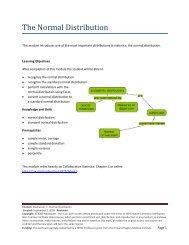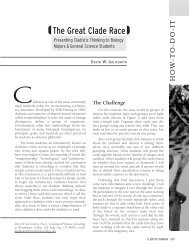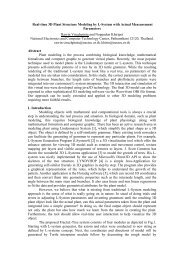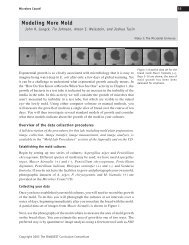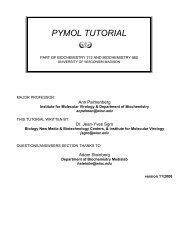THE USE OF TRADITIONAL METHODS OF BIRTH CONTROL ...
THE USE OF TRADITIONAL METHODS OF BIRTH CONTROL ...
THE USE OF TRADITIONAL METHODS OF BIRTH CONTROL ...
Create successful ePaper yourself
Turn your PDF publications into a flip-book with our unique Google optimized e-Paper software.
From: DISCOVERING NORMALITY IN HEALTH AND <strong>THE</strong> REPRODUCTIVE BODY<br />
Proceedings of a Workshop Held at the Program of African Studies, Northwestern University, March 9-10, 2001<br />
PAS Working Papers, Number 11, pp 71-81; Edited by Caroline Bledsoe<br />
Program of African Studies, Northwestern University, 620 Library Place, Evanston, IL 60208-4110, U.S.A.<br />
© 2002 Caroline Bledsoe and No. 11 PAS Working Papers authors.<br />
POSTMODERN CONTRACEPTION:<br />
<strong>THE</strong> <strong>USE</strong> <strong>OF</strong> <strong>TRADITIONAL</strong> <strong>METHODS</strong> <strong>OF</strong> <strong>BIRTH</strong> <strong>CONTROL</strong><br />
AMONG UPPER CLASS WOMEN IN INDIA<br />
Alaka Malwade Basu<br />
INTRODUCTION<br />
Every academic discipline has what in legalese are called “terms of art.” A term of art is an ordinarysounding<br />
word or phrase that has a specific technical designation related to the original definition but is<br />
more precise. Thus the word “damages” in law means the monetary quantification of the harm that<br />
someone might suffer because of a breach of contract or injury due to negligence, as opposed to<br />
“damage” in the descriptive sense of the affected body part, etc. The two concepts are related but one is<br />
more particularized. In effect the art is the legal art into which the term has been subsumed, so that (at<br />
least as a lawyer) one cannot any longer use the term in its naive sense.<br />
Demography has appropriated several such terms of art from everyday language, causing some confusion<br />
for the numerous lay groups and persons who now use a demographic argument to lobby for a variety of<br />
social and political causes. 1 It is not surprising that these lay groups in turn appropriate the terms of art in<br />
demography but forget that the Oxford English Dictionary is not the right place to seek the meaning of<br />
these terms. To give a recent example, Saheli, one of the most visible women‟s groups in India, has taken<br />
the Indian government to task for promoting, and indeed enforcing, sex-selective abortions because of its<br />
goal of a Net Reproduction Rate (NRR) of one person. Saheli staff have taken the trouble to find out that<br />
an NRR of one implies that each woman is replaced in her lifetime by one girl in the next generation and<br />
concluded that the government‟s goal of an NRR of one forces each woman to stop with one daughter<br />
(rather than with two children, of whatever sex happens to come along).<br />
Such misunderstandings are regrettable but understandable. We cannot have the whole world of social<br />
activism trained in technical demography. What is less excusable is the tendency for demographers<br />
themselves to forget that many innocuous sounding words/terms in demography have a more restricted<br />
meaning than that implied by a lay dictionary or by common usage in the everyday world. I illustrate this<br />
tendency with demographic interest in „traditional methods‟ of contraception. The term “traditional<br />
methods” is a demographic term of art, strictly speaking it refers to the noninvasive and nonmaterial ways<br />
of preventing pregnancy; more specifically, to periodic abstinence (or rhythm), withdrawal, and terminal<br />
abstinence. Increasingly, however, the literature uses the term in a normative way, to indicate behaviors<br />
that are inefficient, unmotivated and somehow ignorant. By extension, those women/couples who persist<br />
in using traditional methods of contraception are seen as being inefficient, unmotivated or backward. The<br />
semantic contempt for traditional methods of birth control is also reflected in the changing vocabulary<br />
associated with them. In the 1970s they were often referred to as “natural” methods of contraception; then<br />
the term “traditional methods” got more firmly entrenched. In more recent times, demographers have<br />
labeled these as “ineffective methods,” thereby damning them with one stroke. This is how they are<br />
referred to, for example, in the tables in Zachariah et al. (1994, 109) which is a book on the demographic<br />
transition in Kerala, the one state in which Indian women presumably know what they are doing when<br />
they choose their method of birth control.<br />
1 See Basu (1998) on this renewed public role of demographic research in areas that are far removed from matters of fertility and<br />
mortality.
Given this attitude and this confusion of a term of art with normal everyday language, it is not surprising<br />
that the demographic literature has gone to some lengths to equate the success of family planning<br />
programs in developing countries with their success in pushing “modern” methods of birth control—that<br />
is, the pill, the IUD, sterilization, injections, and now, though more out of the need to worry about STDs<br />
than with any real faith in its contraceptive powers, condoms. That this measure of success is taken<br />
seriously is evident also from attempts in the recent literature to add some measure of traditional<br />
contraceptive use to our calculations of unmet need for contraception. Unmet need is not provided any<br />
longer by only those couples who say that they do not want another child but are not using „any‟ form of<br />
contraception; it is advisable to include in this calculation also those women who are using traditional<br />
methods of birth control.<br />
This line of reasoning is not entirely unjustified. Use-effectiveness studies do find that traditional methods<br />
of birth control have high failure rates (that is, a larger proportion of their users ends up pregnant than do<br />
users of more modern methods). But partly this is because at the start of a fertility transition, the users of<br />
traditional forms of birth control seem to be those least motivated to control their fertility or else those<br />
least able to access more efficient forms of birth control. This disappointment and clucking of tongues<br />
about traditional methods of contraception, however, is unwarranted as family planning programs<br />
get more securely embedded in societies and as fertility transitions proceed. This is so even for<br />
developing countries. Available data on contraceptive use tell us that high or especially increasing levels<br />
of use of these methods do not necessarily reflect a poor family planning program nor do they reflect<br />
inefficient contraception. As a consequence, they need not represent an underlying unmet need for<br />
contraception and nor are they the stick with which to beat family planning program administrators.<br />
In most parts of the world today, it is not the poorest or the least motivated or those with the least access<br />
to “modern” birth control that seem to prefer the less invasive traditional forms of contraception category.<br />
Condoms should also be added to this “traditional” contraception because condoms have existed and been<br />
in use for centuries. It is true that at the start of the age of modern contraception, traditional methods were<br />
used most frequently by those who resisted these modern methods or otherwise had poor access to them.<br />
But these early users of traditional contraception also had another characteristic to them, related to their<br />
self-perceptions of the “normal” body, to which I will return shortly. As the fertility transition has<br />
progressed, we have had quite an inversion of preferences. Now increasingly the most modern and the<br />
lowest fertility groups seem to practice these supposedly inefficient forms of birth control. Tables 5.1 and<br />
5.2 for India illustrate my point. For the country as a whole, as well as for the major states, prevalence<br />
levels of traditional traditional methods and condoms together account for 6.3 percent of total<br />
contraceptive use among rural illiterate women, and to a full 50 percent for urban women with a college<br />
degree. Incidentally, absolute levels of use (that is, not merely as a proportion of all use) of these methods<br />
are also higher among the educated urban group. In such a situation, it requires some stretching of the<br />
imagination to equate „traditional methods‟ of birth control with “traditional” attitudes or ignorance.<br />
As for efficiency of use, based on the Indian NFHS, for women aged 30-44 (that is, women generally at<br />
the end of their childbearing experience), for urban degree holders, the mean number of children born is<br />
2.1 for all women, 2.6 for sterilized women, and 1.8 for users of rhythm and withdrawal. That is, the users<br />
of traditional methods end up with lower fertility than the average for their group as a whole as well as the<br />
users of the more “effective” methods like sterilization. By contrast, for rural illiterate women (those that<br />
make up my first category in the section that follows), the mean CEB is 4.7, that for sterilized women is<br />
4.6, and that for users of traditional methods is higher than both at 5.1. Efficiency of method therefore is<br />
very much a function of the nature of the user.<br />
What does one make of this Are the IUD, the pill, and sterilization increasingly the poor woman‟s<br />
methods, while the rich, educated, urban woman prefers to trust withdrawal, rhythm, or perhaps a<br />
combination of these in conjunction with the condom That seems to be the case as shown in Tables 5.1
and 5.2. But the richer, educated, urban woman can hardly be basing her choice on the monetary costs of<br />
other kinds of contraception or on the social difficulty of finding contraceptive services. In the Indian case<br />
illustrated in the two tables, she can also not be suspected of having religious reasons for preferring these<br />
noninvasive and non-chemical methods, an argument that has often been made to explain why<br />
rhythm and withdrawal account for a quarter of all contraceptive use in the developed countries today<br />
(UN Population Division 1999).<br />
One might argue that upper class women face more “facilitating” conditions for such traditional<br />
contraceptive use. For example, they may have better access to the “husband-wife communication” that<br />
the “Knowledge, Attitude and Practice” (KAP) surveys consider so important for effective birth control<br />
and more important when the method of choice requires the kind of spousal cooperation that these<br />
traditional methods do. More importantly, they may be better able to deal with contraceptive failure<br />
because they have both a higher capacity to afford an additional child (though this is debatable) and better<br />
and easier access to abortion. We do not really have data on class differentials in abortion because most<br />
upper class abortions are performed in private health facilities and no reliable records exist of their<br />
numbers. What we do know is that once services are available, there is hardly any moral or religious or<br />
even health-related opposition to abortion in India. In all classes of women, the overwhelming majority<br />
see nothing wrong with an abortion if circumstances do not favor a birth.<br />
But these are all classic “demographic” explanations. And while they are certainly plausible, they need<br />
not be complete explanations at all. From a reading of the anthropological and psychological literature on<br />
women‟s attitudes towards their bodies, I am tempted to speculate on another kind of differentiation<br />
between upper and lower more than such categories are a convenient shorthand for other kinds of<br />
markers, such as education, income, urban-rural resources, all variables that differentiate the “modern”<br />
from the “traditional woman” class women that may account for this dichotomy in contraceptive<br />
preferences. I think these different groups of women differ in what they define as “normal” in their<br />
reproductive and sexual bodies.<br />
To articulate these speculations is a large undertaking, given the great paucity of the kind of research<br />
literature one would need to make a strong case, but in the following paragraphs I attempt such an<br />
articulation centered around the concept of the “medicalization” of the female body. I identify three stages<br />
of such medicalization (or its absence) and suggest that these three levels of medicalization combine with<br />
(and often contribute to) other kinds of socioeconomic variation/change to produce three broad categories<br />
of women defined in terms of what they consider normal. One can look at these degrees of medicalization<br />
as a progression that accompanies development, but it is also possible to consider the matter crosssectionally.<br />
I identify three categories of women, who face, respectively, the three regimes that I call<br />
premedicalization, medicalization and postmedicalization of the female body.<br />
PREMEDICALIZATION AND <strong>THE</strong> “NORMAL BODY”: “NORMAL” IS WHAT<br />
O<strong>THE</strong>RS THINK<br />
In countries with strong family planning programs, it is increasingly difficult to find poor,<br />
rural, nonliterate women who actively resist modern contraception, but they do exist. The<br />
demographic literature on these women and on those who, in larger numbers in the past,<br />
were wary of contraception even when they wished to have fewer children offers us some<br />
useful hints as to what constitutes the “normal” sexual and reproductive body in their<br />
discourse. Two kinds of data are helpful in this respect: those reasons for not using a modern<br />
method of contraception and those on reasons for discontinuing use after it has been begun.<br />
Aside from the question of those who stop because they want a pregnancy, the most frequent<br />
dissatisfaction with modern birth control relates to its negative impact on health in general<br />
and in particular to the menstrual problems and irregularities it was believed to cause (for<br />
example, see the reasons for discontinuation cited in the two national level family planning
surveys of 1970 and 1980 in India (Khan and Prasad 1983).<br />
At first glance, it might appear that what matters just the personal experience of the disruption in<br />
menstrual regularity. On a closer look at the meaning of menstruation in the lives of traditional women in<br />
India, however, we are confronted with other possibilities. Most of this literature stresses the public nature<br />
of the menstrual experience; from the public (meaning family or kin or community) celebration of<br />
menarche to the various menstrual taboos that make the menstruating woman visible through her<br />
invisibility. That is, the menstruating woman is not supposed to do a variety of things that involve<br />
interaction with others. In a life that is otherwise so interactive, these monthly periods of isolation are<br />
naturally well noted (Uberoi 2001).<br />
At the same time, in spite of the embarrassment and “shame” attached to the bodily function associated<br />
with such public knowledge, menstruation is “not seen as an illness or a pathology…on the contrary, as<br />
long as it occurs at the proper time in life and regularly, it is seen as a link between the human world and<br />
the cosmic order” (Uberoi 2001; Das 1988; Ram 1998). What is seen as awkward and needing<br />
explanation is precisely the opposite— irregular or infrequent or delayed or too heavy menses—all<br />
consequences cited in the literature as being caused by modern contraception in cases where women have<br />
decided to abandon the contraceptive involved. This is the case even when the change in menstrual<br />
patterns is not otherwise medically harmful and may even make life easier for the woman, as discussed in<br />
the next sub-section.<br />
For these women, whose assurance of “normal” bodily function depends on the endorsement of others, an<br />
unmet need for family planning cannot be met merely with more modern contraceptive services. 2 It can<br />
be met with help in using traditional methods of birth control more effectively (not at all an easy prospect<br />
given the kind of cooperation and personal motivation and knowledge required) or with the social change<br />
that makes public knowledge and approval less important in self-representations of the healthy body as<br />
well as with a medicalization of the body that is conducive to accepting benign changes in bodily<br />
function. The last two sets of circumstances have promoted the much higher prevalence of modern<br />
contraception in urban areas and among educated women and women who have faced the full brunt of a<br />
typical family planning program‟s persuasive artillery. I discuss this second set of women next.<br />
MEDICALIZATION AND <strong>THE</strong> “NORMAL BODY”: “NORMAL” IS WHAT SUITS<br />
MY OWN CONVENIENCE<br />
An emerging body of anthropological work on the changing circumstances of women comments on the<br />
giving up of many of the ritual practices of traditional life with socioeconomic change. One of the most<br />
easily discarded seems to be the menstrual taboo, at least in its older all-pervasive form. Several studies of<br />
urban slums in particular comment on the finding that these women now seem to practice only the most<br />
basic form of menstrual isolation—that of staying away from any religious rituals. Otherwise, the<br />
menstruating day is like any other in the lives of these women, albeit more uncomfortable and painful. In<br />
the words of Puri (1999), menstruation now enters “an individualized, privatized domain of experience<br />
and concern.” If concepts of pollution still exist, there has been a shift from the idea of ritual purity to that<br />
of personal hygiene, a shift that is nurtured by the medical and popular-medical information that is now<br />
available to these women, for example, the advice columns of magazines and the marketing of products to<br />
aid in personal hygiene. Not surprisingly, change in the public demonstration of menstrual status and the<br />
new stress on its individualized experience seems to be connected with a sea change in the attitude to<br />
2 In addition, it is quite likely that this endorsement by others will be withheld if the body is represented as sexual but nonreproductive,<br />
even if its menstruating functions are intact. That is, overt contraceptive use itself may also constitute an<br />
abnormality. But this has decreased, with the spread of an aggressive and highly visible family planning program in India that has<br />
brought the idea of birth control very firmly into people‟s consciousness.
menstruation. Now it is less likely to be regarded as something whose regularity and intensity are to be<br />
preserved at all costs. Indeed, as long as “modern medicine” and its practitioners can convince women<br />
that amenorrhoea and lighter bleeding have no other significance for health, such a lessening of the<br />
menstrual burden is actually welcomed and even sought out. Thus, for example, George (1994) reports<br />
that many poor urban women describe menstruation as a “bother” and a “vexation.” In particular, once<br />
they have attained their desired family size, these women are emphatic in wishing that menstruation<br />
would cease: “If there is a magic to stop periods, that magician should be brought here” (respondent<br />
cited in George 1994; see also, Rajadhyaksha 1995; Geetha 1999; Vatuk 1980; Lamb 1999; Uberoi 2001;<br />
Jacobson 1977; Patel 1994). 4<br />
From this perspective, modern contraceptives (especially the oral pill and female sterilization) are seen as<br />
welcome medical interventions because they come with so many additional advantages. Not only do they<br />
prevent pregnancy, the logistics of their use are so much more convenient and practical, and they also<br />
often lessen the hassle of monthly periods, either by greatly decreasing their intensity, or in the case of the<br />
IUD, by increasing menstrual flow. 5 Such interference with the menstrual period, unusually early<br />
menopause too (as long as desired family sizes have been obtained) are not seen as something<br />
“abnormal.” Instead they are welcomed and seen as contributing to the betterment of the physical self. 6<br />
Thus there is little emotional distress associated with menopause, as long as the woman is not barren.<br />
The bureaucratic nature of the family planning program, in a perverse way, aids this process because it is<br />
seen to promote a medical, scientific, rational approach to the body. Indeed, as Rele and Kanitkar (1980)<br />
discuss with reference to the great popularity of sterilizations among lower middle-class women in urban<br />
areas in the 1970s and 1980s, even the terminology of modern contraception seems to give these women a<br />
sense of well-being and control. Sterilizations are not called sterilizations or tubectomies or vasectomies;<br />
instead they are referred to by the generic English word “operation” whatever the language of discourse,<br />
and are seen as belonging to the world of modern medicine and rational behavior which the modern<br />
individual aspires to. Moreover, talk of these operations is safe because it does not require any mention of<br />
sexual or reproductive parts or activities in the way that “traditional” methods such as withdrawal or<br />
rhythm do.<br />
An attitude that views the female body in such functional as well as “scientific” terms is naturally more<br />
conducive to family planning program interventions than is a worldview that defines the “normal” body<br />
in terms of how others see it. To that extent, low levels of modern contraceptive use in a population may<br />
indeed reflect a greater traditionalism in that population. But at some point on this move to modernity, the<br />
linearity seems to disappear and we get what may be called post-modern women. But in a paper that<br />
stresses the need for more attention to semantics, perhaps “post-modern” is not the right way to describe<br />
the “new woman,” given the specific connotations that are now attached to that word. Perhaps “neo-<br />
4 Incidentally, it is interesting that one of the few good things that the women had to say about menstruation once its reproductive<br />
role was over was that it provided them with one of the few legitimate reasons to avoid sexual relations.<br />
5 This kind of finding also underscores the complexity of the decision to adopt modern contraception and the fair amount of<br />
agency involved. That is, there is a reasoning behind acceptance of even those methods of birth control that have menstrual sideeffects;<br />
it is not merely a demonstration of the coercive powers of the programs as many commentators simplistically assume.<br />
6 Indeed, they may be seen as contributing to the betterment of the psychological self as well. According to some observers (see,<br />
for example, Saavala [1999] on rural South India), public knowledge about effective contraceptive practice by the contemporary<br />
poor woman, especially when the method is as effective as sterilization, can increase her freedom of movement and general<br />
autonomy because there is less fear of her shaming family honor by an extramarital pregnancy. Therefore the young sterilized<br />
woman often gets previously privileges accorded only to the much older non-sexual woman. Both these categories are seen to be<br />
nonreproductive and that is what finally matters.
modern” expresses more neutrally what I am trying to convey here. The attitude of the well-educated,<br />
upper-class autonomous woman whose modernism has gone far enough to question long-entrenched<br />
notions of scientific, rational, westernized behavior. So “neo-modern” is the term that I will use in the rest<br />
of the text; however in the title of the paper, I retain “post-modern” because it may convey more aptly the<br />
“flavor” if not the substance of my argument.<br />
POST-MEDICALIZATION AND <strong>THE</strong> “NORMAL” BODY: “NORMAL” IS WHAT<br />
“NATURE” INTENDED<br />
For women in developing countries, the definition of what constitutes a “normal” reproductive and sexual<br />
body becomes what I call neo-modern. As they acquire more education and money, medicalization tells<br />
women to trust unhesitatingly western modern modes of treatment, whether of illness or of unwanted<br />
fecundity. Instead, the female body is regarded a temple to be nurtured and saved from the worst ravages<br />
of modern life, including modern medicine (except in the immediate short-term; for example, to treat an<br />
acute infection or to abort a second female pregnancy, western technologies are very handy). For more<br />
chronic conditions birth control is seen as a viable treatment and it makes much more sense to rely on<br />
noninvasive, “natural” therapies that require more effort but do not harm bodily integrity. If this approach<br />
becomes burdensome, there is always the option of a one-step procedure such as an irreversible<br />
sterilization with all its attendant assaults on the normal body.<br />
The high levels of use of traditional methods of birth control among educated women and among urban<br />
women are not surprising in this framework. They are also consistent with what we know about the<br />
determinants of alternative therapies in general. These tend to be adopted most easily for chronic<br />
conditions by the higher educated or by the economically better-off all over the world (for example,<br />
Eisenberg et al., 1993, 1998; Thomas et al. 1991; Astin 1998). 7 One of the greatest factors promoting such<br />
“traditional” methods of prevention and treatment is not the perceived ineffectiveness of modern methods<br />
but the their unwholesome side-effects, a finding consistent with the most common reason<br />
given for discontinuing contraception in family planning surveys (Bongaarts and Bruce 1996).<br />
In the Indian context, this change in what constitutes normality in upper class women and the greater<br />
“body-consciousness” (see Uberoi 2001) is reflected in the booming interest in the beauty industry. But<br />
here too, the greatest emphasis is on beauty products that are in some way “natural”—virtually every<br />
street in the large cities of India now boasts an “herbal” beauty parlor. A recent book on herbal remedies<br />
for women which was produced by an NGO to help “traditional” women surprised its producers by being<br />
sold out in the cities in no time (Shodhini 1997). According to newspaper reports, traditional sex experts<br />
in the country (who base their medication on ayurvedic medicine) are unperturbed by the advent of<br />
Viagra in India, they believe (probably rightly) that their customers will remain loyal to their “safer”<br />
technologies.<br />
As several sociologists have pointed out, this heightened interest in “nature” is not really an outcome of a<br />
straightforward Westernization. Indeed, it may be the women in category two above who are more simply<br />
Westernized in this sense. Instead it may well be seen as a growing nationalism in the post-modern Indian<br />
woman for much publicity is now given to all the Indian origins of these herbal and other systems of<br />
beauty and medicine (Uberoi 2001; Puri 1999). The „holistic‟ approach to health and beauty is believed to<br />
be the scaffolding on which traditional systems of medicine in India are built. Curiously, the back-to-<br />
7 They are also associated with a greater tendency to eat organic foods in general and to be environmentally<br />
conscious. Seen in this larger framework, perhaps the great resort to „traditional‟ birth control in Western Europe<br />
is also not surprising and perhaps we may be misinterpreting the causes by focussing so greatly on the religious<br />
reasons for eschewing modern contraception.
nature attitude to the reproductive and sexual self in upper class women breaks down when it comes to<br />
menopause (Uberoi 2001). Increasingly, menopause is viewed as a problem rather than a welcome stage<br />
of life as it is for the women in the last category and is medicalized in the same way as it is in the West.<br />
Hormone replacement therapy is becoming increasingly popular and there is less patience with the idea<br />
that the menopausal woman is also a non-sexual being. Perhaps, it is the post-neomodern Indian woman<br />
who will find her traditional roots in this area of life.
REFERENCES<br />
Astin, J.A. 1998. “Why patients use alternative medicine: results of a national study,” Journal of the American<br />
Medical Association 280(19).<br />
Basu, Alaka Malwade. 1997. “The Politicization of Fertility to Achieve Non-demographic Objectives.” Population<br />
Studies 51(1): 5-18.<br />
Bongaarts, J, and J. Bruce. 1995. “The Causes of Unmet Need for Contraception and the<br />
Social Content of Services,” Studies in Family Planning 26(2).<br />
Das, Veena. 1988. “Femininity and the Orientation to the Body.” In Karuna Chanana, ed., Education, Socialization<br />
and Women: Explorations in Gender Identity, 193-207. New Delhi: Orient Longman.
Eisenberg, D.M., R.C. Kessler, C. Foster, F.E.Norlock, D.R. Calkins and T.L. Delbanco. 1993. “Unconventional<br />
medicine in the United States: Prevalence, costs and patterns of use,” New England Journal of Medicine (328) 4.<br />
Eisenberg, D.M., R.B. Davis, S.L. Ettner, S. Appel, S. Wilkey, M. Van Rompay and R.C. Kessler. 1998. “Trends in<br />
alternative medicine use in the United States,” Journal of the American Medical Association (283)7.<br />
Geetha, V. 1999. “Three Tales of Ageing.” Economic and Political Weekly 34(44): 63-65.<br />
George, A. 1994. “It Happens to Us: Menstruation as Perceived by Poor Women in Bombay,” in J. Gittelsohn et al.<br />
(edited), Listening to Women Talk About Their Health: Issues and Evidence from India, New Delhi, Har-Anand<br />
Publications. 80 Discovering Normality in Health and the Reproductive Body<br />
International Institute for Population Studies (IIPS). 1995. National Family Health Survey 1992-93, Bombay, IIPS.<br />
Jacobson, Doranne. 1977. “The Women of North and Central India: Goddesses and Wives.”In D. Jacobson and S.<br />
Wadley, eds., Women in India: Two Perspectives. New Delhi: Manohar.<br />
Khan, M. E. and C.V.S. Prasad. 1983. Family Planning Practices in India: Second All-India Survey. Baroda, India,<br />
Operations Research Group.<br />
Lamb, Sarah. 1999. “Aging, Gender and Widowhood: Perspectives from Rural West Bengal.” Contributions to<br />
Indian Sociology 33(3): 541-70.<br />
Patel, Tulsi. 1994. Fertility Behaviour: Population and Society in a Rajasthan Village. Delhi: Oxford University<br />
Press.<br />
Puri, Jyoti. 1999. Women, Body, Desire in Post-Colonial India. New York: Routledge. Ram, Kalpana. 1998.<br />
“Uneven Modernities and Ambivalent Sexualities: Women‟s Constructions of Puberty in Coastal Kanyakumari,<br />
Tamilnadu.” In Mary E. John and Janaki Nair, eds., A Question of Silence: The Sexual Economies of Modern India,<br />
269-303. New Delhi: Kali for Women.<br />
Rajadhyaksha, Tarini. 1995. “The Female Life-cycle with Special Reference to the Female<br />
Body in Everyday Life: A Case Study from Maharashtra. PhD dissertation, Department of Sociology, University of<br />
Delhi.<br />
Rele, J.R. and T. Kanitkar. 1980. Fertility and Family Planning in Greater Bombay. Bombay: Popular Prakasan.<br />
Saavala, M. 1999. “Understanding the Prevalence of Female Sterilization in Rural South India,” Studies in Family<br />
Planning 30(4).<br />
Shodhini Collective. 1997. Touch Me, Touch-me-not: Women, Plants and Healing. New Delhi: Kali for Women.<br />
Thomas, K.J., J. Carr, L. Westlake and B.T. Williams. 1991. “Use of Non-orthodox and Conventional Health Care<br />
in Great Britain,” vol. 302.<br />
Uberoi, Patricia. 2001. “The Woman‟s Body in Mid-life: Sociocultural and Medical Perspectives from South Asia.”<br />
New Delhi, Institute of Economic Growth, Occasional Papers in Sociology No. 4. United Nations. 1999. Patterns of<br />
Contraceptive Use. New York: U.N. Population Division. Postmodern Contraception 81<br />
Vatuk, Sylvia. 1980a. The Aging Woman in India: Self-perceptions and Changing Roles. In Alfred D‟Souza, ed.,<br />
Women in contemporary India and South Asia, 287-309. Delhi: Manohar.<br />
Zachariah, K.C., S. Irudaya Rajan, P.S. Sarma, k. Navaneetham, P. S. Gopinath Nair and U.S. Misra. 1994.<br />
Demographic Transition in Kerala in the 1990s. Trivandrum, India: Centre for Development Studies.




